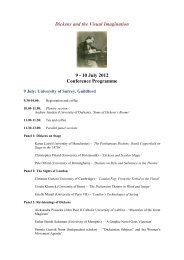The targeted killing of terrorists on foreign soil - Institute of Advanced ...
The targeted killing of terrorists on foreign soil - Institute of Advanced ...
The targeted killing of terrorists on foreign soil - Institute of Advanced ...
You also want an ePaper? Increase the reach of your titles
YUMPU automatically turns print PDFs into web optimized ePapers that Google loves.
Tobias Ruettersh<str<strong>on</strong>g>of</str<strong>on</strong>g>f<br />
Panel 4 (a)<br />
3.2.2 Self-defence against <str<strong>on</strong>g>terrorists</str<strong>on</strong>g>?<br />
Against this background, the questi<strong>on</strong> arises whether self-defence can be applied to terrorist<br />
targets? <str<strong>on</strong>g>The</str<strong>on</strong>g> customary principles <str<strong>on</strong>g>of</str<strong>on</strong>g> immediacy, necessity and proporti<strong>on</strong>ality as reflected in<br />
the Webster doctrine have to be analysed in this c<strong>on</strong>text. Firstly, the restricti<strong>on</strong> <str<strong>on</strong>g>of</str<strong>on</strong>g> immediacy is<br />
c<strong>on</strong>cerned with temporal limits to self-defence. If the attack is already taking place, it is clear<br />
that resp<strong>on</strong>ses must not be limited to “<strong>on</strong>-the-spot-reacti<strong>on</strong>[s]” (Dinstein 2005, 220). A selfdefence<br />
measure satisfies the immediacy criteri<strong>on</strong> if there is no undue time lag between the<br />
attack and the self-defence measures (ibid., 210). For example, the time frame between the<br />
terrorist attacks <str<strong>on</strong>g>of</str<strong>on</strong>g> September 11 th , 2001 and the begin <str<strong>on</strong>g>of</str<strong>on</strong>g> operati<strong>on</strong> “Enduring Freedom” in<br />
Afghanistan <strong>on</strong> October 7 th , 2001 is generally seen as proporti<strong>on</strong>ate and c<strong>on</strong>sistent with the<br />
right to self-defence (see Schmitz-Elvenich 2007, 130). This also applies to terrorist acti<strong>on</strong>s, if<br />
they appear as a series <str<strong>on</strong>g>of</str<strong>on</strong>g> attacks. If there is a c<strong>on</strong>sistent pattern to them, they can be seen as an<br />
accumulati<strong>on</strong> <str<strong>on</strong>g>of</str<strong>on</strong>g> events which counts as <strong>on</strong>e armed attack (see Cassese 1989, 596). A different<br />
situati<strong>on</strong> occurs, if an armed attack is anticipated and self-defence measures are taken before<br />
the actual attack takes place. In terms <str<strong>on</strong>g>of</str<strong>on</strong>g> <str<strong>on</strong>g>targeted</str<strong>on</strong>g> <str<strong>on</strong>g>killing</str<strong>on</strong>g>, this would mean that such an<br />
operati<strong>on</strong> could already be c<strong>on</strong>ducted before <str<strong>on</strong>g>terrorists</str<strong>on</strong>g> have made an attack. <str<strong>on</strong>g>The</str<strong>on</strong>g>re are two<br />
different categories <str<strong>on</strong>g>of</str<strong>on</strong>g> the use <str<strong>on</strong>g>of</str<strong>on</strong>g> force in such anticipatory self-defence: pre-emptive and<br />
preventive. Pre-emptive use <str<strong>on</strong>g>of</str<strong>on</strong>g> force means that a state reacts to an imminent threat. A state<br />
that pre-empts basically has the choice between hitting first or getting the first blow. In<br />
essence, pre-empti<strong>on</strong> mandates certainty about an armed attack in the very near future (Gray<br />
2007, p. 13). When “danger [is] immediate, and, as it were, at the point <str<strong>on</strong>g>of</str<strong>on</strong>g> happening” (Grotius<br />
1949, cited after Kegley/Raym<strong>on</strong>d 2003, 389), pre-emptive acti<strong>on</strong> is allowed and legitimate.<br />
This is also the view <str<strong>on</strong>g>of</str<strong>on</strong>g> the UN Secretary General (UN 2005, para. 124). Hence, there seems to<br />
be an opinio juris communis that such a right exists (see Krajewski 2005, 12). In c<strong>on</strong>trast, a<br />
preventive use <str<strong>on</strong>g>of</str<strong>on</strong>g> force entails the use <str<strong>on</strong>g>of</str<strong>on</strong>g> military force to remove a potential future threat<br />
which might appear <strong>on</strong> the horiz<strong>on</strong> but is not yet imminent (see e.g. Gray 2007, 11;<br />
Kegley/Raym<strong>on</strong>d 2003, 388). <str<strong>on</strong>g>The</str<strong>on</strong>g> state <str<strong>on</strong>g>of</str<strong>on</strong>g>ten even has the choice to tolerate such a possible<br />
incident (Gray 2007, 13). It is widely acknowledged by scholars that preventive military acti<strong>on</strong><br />
is certainly unlawful and inadmissible as it would result in a “bottomless legal pit”<br />
(Kaplan/Katzenbach 1961, 213).<br />
Sec<strong>on</strong>dly, the principle <str<strong>on</strong>g>of</str<strong>on</strong>g> necessity requires that the state <strong>on</strong>ly resp<strong>on</strong>ds to an armed attack<br />
with the use <str<strong>on</strong>g>of</str<strong>on</strong>g> force when other defensive measures are not available or not sufficient enough<br />
(see Dinstein 2005, 210). C<strong>on</strong>cerning the <str<strong>on</strong>g>targeted</str<strong>on</strong>g> <str<strong>on</strong>g>killing</str<strong>on</strong>g> <str<strong>on</strong>g>of</str<strong>on</strong>g> <str<strong>on</strong>g>terrorists</str<strong>on</strong>g>, this would raise the<br />
questi<strong>on</strong> if policing or other less forceful measures are possibly effectual to eliminate the<br />
terrorist threat (see Schmitt 2002, 28). However, as dem<strong>on</strong>strated above, this opti<strong>on</strong> is not<br />
- 13 -
















